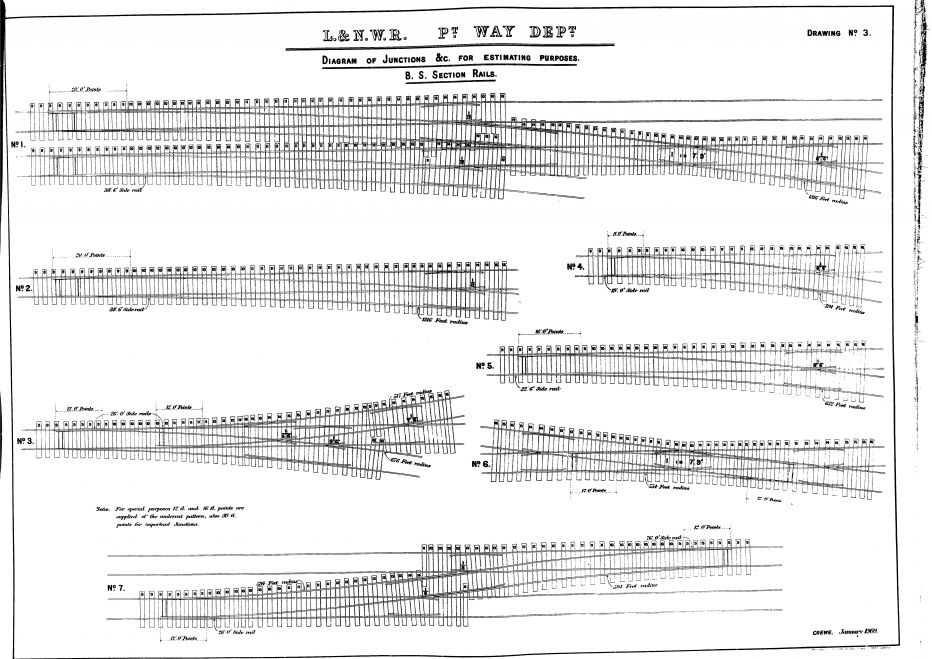Templot Club Archive 2007-2020
|
|||
| author | remove search highlighting | ||
|---|---|---|---|
|
posted: 19 Jul 2015 10:28 from: Keith N
click the date to link to this post click member name to view archived images |
Hi all I have made up a template for a double junction and got to the point (sic) where the sleepers need to be adjusted. I have had a go at shoving and have got the basics of how it works. But how do I know what goes where? Are there any plans/photos, which show the timbers clearly, which I can use as a guide? Cheers Keith |
||
| Attachment: attach_2147_2726_Double_Junction_new2c.box 201 | |||
|
posted: 19 Jul 2015 17:39 from: Trevor Walling
click the date to link to this post click member name to view archived images |
Hello Keith, The timbers are sorted by lengthening some and removing others.2110_191228_080000000.png  If you lengthen X8,X7,X6 and X5 right across to the bottom over the short timbers of both routes and then remove the short ones that would be ok,Any short timbers that overlap would be ok if you shove them about so they interlace without touching each other. Different regions and periods have various preferences as to the arranging of timbers.A lot depends on the individual permanent way gangers managers decisions. Regards. Trevor. |
||
| Last edited on 19 Jul 2015 19:53 by Trevor Walling |
|||
|
posted: 19 Jul 2015 19:24 from: Keith N
click the date to link to this post click member name to view archived images |
Hi Trevor Something like this I made the timbers in two pieces because I wondered whether you could actually get sleepers long enough to cross two complete tracks! Cheers Keith |
||
| Attachment: attach_2148_2726_Double_Junction_new2d.box 210 | |||
|
posted: 19 Jul 2015 20:16 from: Trevor Walling
click the date to link to this post click member name to view archived images |
Hello Keith, I don't think the bottom of X8 would be satisfactory as the chair would be very near the end. Crossing timbers are also required to ensure the component parts of the formation are also tied together to avoid movement. 2110_191505_350000000.png  I think the timbers of sufficient length would be available as such examples can be seen in old images quite frequently. There are circumstances where short timbers could be used interlaced but examples vary according to the company and time period. They tend to be pre-grouping companies where methods where less standardized and more varied. Regards. Trevor. |
||
| Last edited on 19 Jul 2015 20:24 by Trevor Walling |
|||
|
posted: 19 Jul 2015 20:42 from: Trevor Walling
click the date to link to this post click member name to view archived images |
Hello, Here is an example from pre-grouping. 2110_310840_390000000.jpg  |
||
|
posted: 19 Jul 2015 22:19 from: Martin Wynne
click the date to link to this post click member name to view archived images |
Keith N wrote: I have had a go at shoving and have got the basics of how it works.Hi Keith, Generally timbering practice varies across railway companies and periods, the type of traffic flows on each road, local ground conditions, and the mood of the relaying inspector. The only way to be sure you have it right is to model an actual location from photographs. But there are some principles to keep in mind when you imagine yourself as the the p.w.engineer laying out the timbering: 1. the special chairs can only fit the rails in the designed positions, so you must have some timber under those positions. These are the block chairs and slide chairs in a switch, the special crossing chairs, etc. Generally if they are not ordinary chairs they can only go on the rail in one position. 2. timbers should be as square to the rails as can be arranged to prevent gauge-spread. If they must be skewed to the rails they may need to be wider 14" or even 16" timbers so that the skewed chairs are fully supported and can be screwed into solid wood. 3. timbers were available to special order up to about 30ft long. But they were expensive, and difficult to transport and handle, so not used if it could be avoided. For an ordinary crossover at 6ft way, the long timbers at the centre are 20ft long. The longest timbers in a single turnout were typically 15ft long, with interlaced plain sleepers beyond that. 4. timbers should not be too close together side-by-side, so that the gang can get a shovel under them to pack them with ballast to level the rails when needed. 5. likewise timbers should not be too close end-to-end. In that case either a single long timber is used instead, or two shorter timbers are halved and splice together to create a long timber. Such spliced joints have old fishplates bolted across them -- a nice modelling touch. 6. sometimes timbers must be moved from the ideal position to allow for point-rodding runs, signal wires, etc., and must sometimes be shortened at one end to clear catch pits, drains, etc. Here are a few links covering this subject on here: topic 2628 topic 2460 topic 1610 There are many more timbering topics if you do a search. regards, Martin. |
||
| Please read this important note about copyright: Unless stated otherwise, all the files submitted to this web site are copyright and the property of the respective contributor. You are welcome to use them for your own personal non-commercial purposes, and in your messages on this web site. If you want to publish any of this material elsewhere or use it commercially, you must first obtain the owner's permission to do so. |